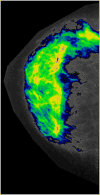Mammographic density does not differ between unaffected BRCA1/2 mutation carriers and women at low-to-average risk of breast cancer
- PMID: 20130984
- PMCID: PMC3125980
- DOI: 10.1007/s10549-010-0749-7
Mammographic density does not differ between unaffected BRCA1/2 mutation carriers and women at low-to-average risk of breast cancer
Abstract
Elevated mammographic density (MD) is one of the strongest risk factors for sporadic breast cancer. Epidemiologic evidence suggests that MD is, in part, genetically determined; however, the relationship between MD and BRCA1/2 mutation status is equivocal. We compared MD in unaffected BRCA1/2 mutation carriers enrolled in the U.S. National Cancer Institute's Clinical Genetics Branch's Breast Imaging Study (n = 143) with women at low-to-average breast cancer risk enrolled in the same study (n = 29) or the NCI/National Naval Medical Center's Susceptibility to Breast Cancer Study (n = 90). The latter were BRCA mutation-negative members of mutation-positive families or women with no prior breast cancer, a Pedigree Assessment Tool score <8 (i.e., low risk of a hereditary breast cancer syndrome) and a Gail score <1.67. A single experienced mammographer measured MD using a computer-assisted thresholding method. We collected standard breast cancer risk factor information in both studies. Unadjusted mean percent MD was higher in women with BRCA1/2 mutations compared with women at low-to-average breast cancer risk (37.3% vs. 33.4%; P = 0.04), but these differences disappeared after adjusting for age and body mass index (34.9% vs. 36.3%; P = 0.43). We explored age at menarche, nulliparity, age at first birth, menopausal status, number of breast biopsies, and exposure to exogenous hormonal agents as potential confounders of the MD and BRCA1/2 association. Taking these factors into account did not significantly alter the results of the age/body mass index-adjusted analysis. Our results do not provide support for an independent effect of BRCA1/2 mutation status on mammographic density.
Figures


Similar articles
-
Mammographic density and breast cancer in women from high risk families.Breast Cancer Res. 2015 Jul 11;17(1):93. doi: 10.1186/s13058-015-0604-1. Breast Cancer Res. 2015. PMID: 26163143 Free PMC article.
-
Mammographic density and breast cancer risk in BRCA1 and BRCA2 mutation carriers.Cancer Res. 2006 Feb 1;66(3):1866-72. doi: 10.1158/0008-5472.CAN-05-3368. Cancer Res. 2006. PMID: 16452249
-
Relationships between computer-extracted mammographic texture pattern features and BRCA1/2 mutation status: a cross-sectional study.Breast Cancer Res. 2014;16(4):424. doi: 10.1186/s13058-014-0424-8. Epub 2014 Aug 23. Breast Cancer Res. 2014. PMID: 25159706 Free PMC article.
-
[Medical management of women with inherited predisposition to breast cancer: indications and procedures for mammographic screening].Bull Cancer. 2001 Jul;88(7):677-86. Bull Cancer. 2001. PMID: 11495821 Review. French.
-
Breast cancer and ovarian cancer genetics.J Long Term Eff Med Implants. 2005;15(5):533-45. doi: 10.1615/jlongtermeffmedimplants.v15.i5.60. J Long Term Eff Med Implants. 2005. PMID: 16218901 Review.
Cited by
-
Beyond breast density: a review on the advancing role of parenchymal texture analysis in breast cancer risk assessment.Breast Cancer Res. 2016 Sep 20;18(1):91. doi: 10.1186/s13058-016-0755-8. Breast Cancer Res. 2016. PMID: 27645219 Free PMC article. Review.
-
High mammographic density is associated with an increase in stromal collagen and immune cells within the mammary epithelium.Breast Cancer Res. 2015 Jun 4;17(1):79. doi: 10.1186/s13058-015-0592-1. Breast Cancer Res. 2015. PMID: 26040322 Free PMC article.
-
Association between Family History of Breast Cancer and Breast Density in Saudi Premenopausal Women Participating in Mammography Screening.Clin Pract. 2024 Jan 19;14(1):164-172. doi: 10.3390/clinpract14010013. Clin Pract. 2024. PMID: 38391399 Free PMC article.
-
Mammographic density and breast cancer in women from high risk families.Breast Cancer Res. 2015 Jul 11;17(1):93. doi: 10.1186/s13058-015-0604-1. Breast Cancer Res. 2015. PMID: 26163143 Free PMC article.
-
Identification of a novel Calotropis procera protein that can suppress tumor growth in breast cancer through the suppression of NF-κB pathway.PLoS One. 2012;7(12):e48514. doi: 10.1371/journal.pone.0048514. Epub 2012 Dec 20. PLoS One. 2012. PMID: 23284617 Free PMC article.
References
-
- Boyd NF, Lockwood GA, Byng JW, Tritchler DL, Yaffe MJ. Mammographic densities and breast cancer risk. Cancer Epidemiol Biomarkers Prev. 1998;7(12):1133–1144. - PubMed
-
- Boyd NF, Guo H, Martin LJ, Sun L, Stone J, Fishell E, Jong RA, Hislop G, Chiarelli A, Minkin S, Yaffe MJ. Mammographic density and the risk and detection of breast cancer. N Engl J Med. 2007;356(3):227–236. - PubMed
-
- Byrne C, Schairer C, Wolfe J, Parekh N, Salane M, Brinton LA, Hoover R, Haile R. Mammographic features and breast cancer risk: effects with time, age, and menopause status. J Natl Cancer Inst. 1995;87(21):1622–1629. - PubMed
-
- Boyd NF, Lockwood GA, Martin LJ, Byng JW, Yaffe MJ, Tritchler DL. Mammographic density as a marker of susceptibility to breast cancer: a hypothesis. IARC Sci Publ. 2001;154:163–169. - PubMed
Publication types
MeSH terms
Grants and funding
LinkOut - more resources
Full Text Sources
Medical
Miscellaneous

